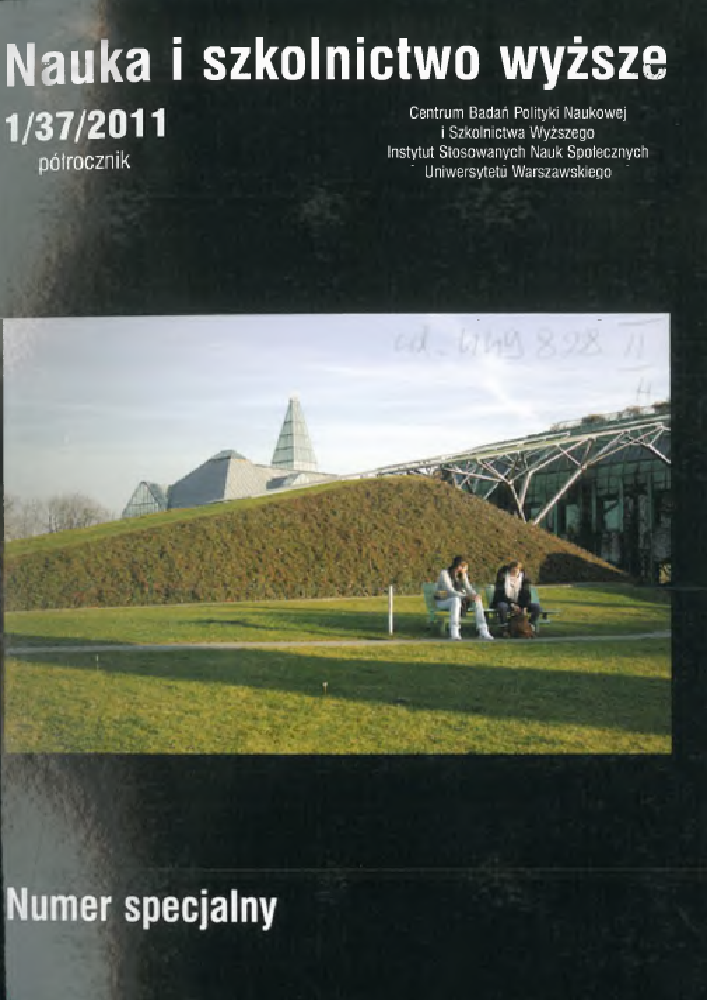Abstract
Nowadays education is becoming a costly investment which influences students’ futurę careers and private lives, employers’ activities and countries’ social and economic development. In order to minimise the risk of making a wrong decision when choosing a university and a field of study, customers seek credible information on aspects such as the quality of educational services and the broadly understood reputation of the school. Websites are an important tool used by universities in their marketing communication. The author presents results of research aimed at evaluating websites maintained by schools of higher education in Poland. She focuses on a selected category of marketing information offered to customers i.e. that concerning the quality of educational services. The analysis covers various methods used by schools of higher education to declare and confirm the quality of their services, i.e. quality assurance policy, mission, accreditations and certificates. The research findings positively verified the initial hypothesis i.e. that Poland’s higher education institutions fail to convey complete information about the quality of educational services via their websites and that they underestimate the role of various tools which can be used to assert and confirm quality to promote their services. The findings have also shown that factors such as organisational and legał status, the number of fields of study and the level of education (undergraduate, postgraduate) have a statistically significant effect on the quality and quantity of information concerning the quality of educational services presented on schools' websites.
References
Boguski J. 2009 Od uniwersytetu tradycyjnego do uniwersytetu przyszłości, „Nauka i Szkolnictwo Wyższe,nr 1/33.
Buchner-Jeziorska A., Boczkowski A. 1996 Procedury i negocjacje. Jakość kształcenia w szkole wyższej, Wydawnictwo Instytutu Socjologii Uniwersytetu Łódzkiego, Łódź.
Chapman R.G. 1986 Toward a Theory of College Selection: A Model of College Search and Choice Behaviour, w: R.J. Lutz (red.): Advances in Consumer Research, 1.1, Association for Consumer Research, Provo, Utah.
Dew J. 2009 Ouality Issues in Higher Education, „The Journal For Ouality & Participation”, kwiecień.
Dietl J. 2004 Czy potrzebne jest zarządzanie marketingowe w szkolnictwie wyższym?, w: G. Nowaczyk, M. Kolasiński (red.): Marketing szkól wyższych, Wydawnictwo Wyższej Szkoły Bankowej w Poznaniu, Poznań.
Doughty D. 2007 Certyfikat w dziedzinie zarządzania i rozwoju zasobów ludzkich - model dla sektora malej i średniej przedsiębiorczości w Polsce, w: O. Konieczny, R. Schmidtke (red.): Inwestycja w kadry. Perspektywa instytucji szkoleniowych, WYG international, Warszawa - Kraków.
Geryk M. 2007 Rynek uczelni niepublicznych w Polsce, Wydawnictwo Szkoty Głównej Handlowej w Warszawie, Warszawa.
How European... 2009 How European Students Perceive Higher Education in Europę, European Commission (www.europa.eu/rapid/).
Iwankiewicz-Rak B. 2004 Zarządzanie marketingowe szkoła wyższą, w: G. Nowaczyk, M. Kolasiński (red.): Marketing szkół wyższych, Wydawnictwo Wyższej Szkoły Bankowej w Poznaniu, Poznań.
Jager J., Plooy T. 2010 Information Sources Used to Select a Higher Education Institution: Evidence from South African Students, „Business Education & Accreditation”, t. 2, nr 1.
Jotkiewicz D. 2005 Ewaluacja szkolnictwa wyższego a jakość kształcenia, „Nauka i Szkolnictwo Wyższe” nr 2/26.
Kloze T. 2006 Akredytacja czy certyfikacja, „ABC Jakości. Akredytacja. Badania. Certyfikacja. Ouality Review”, nr 4.
Kochanowski J. 2008 Komunikacyjny (polilogiczny) model zarządzania jakością w szkole wyższej, „Nauka i Szkolnictwo Wyższe”, nr 1/31.
Krzyżanowska M. 2004 Marketing usług edukacyjnych szkoły wyższej, w: G. Nowaczyk, M. Kolasiński (red.): Marketing szkół wyższych, Wydawnictwo Wyższej Szkoły Bankowej w Poznaniu, Poznań.
Lisiecka K. 2001 Przegląd koncepcji zapewnienia i oceny jakości kształcenia w polskim szkolnictwie wyższym, w: K. Lisiecka (red.): Zapewnienie jakości kształcenia w szkole wyższej, Akademia Ekonomiczna w Katowicach, Katowice.
Łukasik M. 2006 Strategie promocyjne uczelni technicznych w Polsce i w Niemczech, „Świat Marketingu” (czasopismo internetowe), nr 8 (http://www.swiatmarketingu.pl/index.php?rodzaj= 0 1 &id_numer=520690).
Meyer K.A. 2008 The „Virtual Face” of Institutions: What Do Home Pages Reveal about Higher Education?, „lnnovation in Higher Education”, nr 33.
Morley L, Aynsley S. 2007 Employers, Ouality and Standards in Higher Education: Shared Values and Vocabularies or Elitism and lnequalities?, „Higher Education Ouarterly”, t. 61, nr 3.
Mruk H., Pilarczyk B., Szulce H. 2007 Marketing. Uwarunkowania i instrumenty, Akademia Ekonomiczna w Poznaniu, Poznań.
Pluta-Olearnik M. (red.) 2009 Przedsiębiorcza uczelnia i jej relacje z otoczeniem, Difin, Warszawa.
Raport strategiczny... 2008 Raport strategiczny IAB Polska. Internet 2008. Polska. Europa. Świat. (http://www.iab.com.pl).
Ratajczak M. 2002 O powszechności akredytacji, „Forum Akademickie”, nr 1.
Reichert S., Tauch Ch. 2003 Trends 2003. Progress towards European Higher Education Area. Bologna Four Years After: Steps toward Sustainable Reform in Higher Education, European University Association, Geneve (http://www.unizg.hr/unesco/texts/trends_2003_progress_towards_ehea.pdf).
Students and Higher... 2009 Students and Higher Education Reform. Survey among Students in Higher Education Institutions, in the EU Member-States, Croatia, Iceland, Norway and Turkey, „European Commission. Flash Eurobarometer” (www.ec.europa.eu/education/higher-education).
Szczepańska-Woszczyna K. 2004 Wykształcenie absolwentów elementem kształtowania pozycji rynkowej uczelni, w: G. Nowaczyk, M. Kolasiński (red.): Marketing szkól wyższych, Wydawnictwo Wyższej Szkoły Bankowej w Poznaniu, Poznań.
Tremblay K. 2008 OECD Assessment of Higher Education Learning Outcomes (AHELO) Feasibility Study, OECD/IMHE General Conference on Ouality, Relevance and Impact of Higher Education, 8-10 September 2008; Paris (www.oecd.org).
Ustawa... 2010 Ustawa z dnia 30 sierpnia 2002 roku o systemie oceny zgodności. Załącznik do obwieszczenia Marszalka Sejmu Rzeczypospolitej Polskiej z dnia 13 lipca 2010 roku, „Dziennik Ustaw” 2010, nr 138, poz. 935.
Waniowski R, Sobotkiewicz D., Daszkiewicz D. 2010 Marketing. Teoria i przykłady, Placet, Warszawa.
Wójcicka M. 1995 Zapewnienie jakości kształcenia w polskich uczelniach - założenia i wyniki badań ankietowych, w: E. Wnuk-Lipińska, M. Wójcicka (red.): Jakość w szkolnictwie wyższym. Przykład Polski, Centrum Badań Polityki Naukowej i Szkolnictwa Wyższego, Uniwersytet Warszawski, Warszawa.
Wójcicka M. 2001 Jakość kształcenia w szkolnictwie wyższym. Słownik tematyczny, Centrum Badań Polityki Naukowej i Szkolnictwa Wyższego, Uniwersytet Warszawski, Warszawa.
Zailskaite-Jakśte L, Kuvykaite R. 2010 Internet-based Communication with Target Audiences: Case Study of Higher Education Institutions, „Economics and Management”, nr 15.
